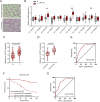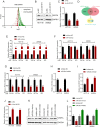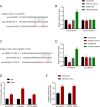The circular RNA 001971/miR-29c-3p axis modulates colorectal cancer growth, metastasis, and angiogenesis through VEGFA
- PMID: 32430042
- PMCID: PMC7236474
- DOI: 10.1186/s13046-020-01594-y
The circular RNA 001971/miR-29c-3p axis modulates colorectal cancer growth, metastasis, and angiogenesis through VEGFA
Retraction in
-
Retraction Note: The circular RNA 001971/miR-29c-3p axis modulates colorectal cancer growth, metastasis, and angiogenesis through VEGFA.J Exp Clin Cancer Res. 2022 Mar 29;41(1):114. doi: 10.1186/s13046-022-02342-0. J Exp Clin Cancer Res. 2022. PMID: 35351172 Free PMC article. No abstract available.
Abstract
Background: Colorectal cancer (CRC) is one of the most common malignant tumors globally. Angiogenesis is a key event maintaining tumor cell survival and aggressiveness. The expression of vascular endothelial growth factor A (VEGFA), one of the most significant tumor cell-secreted proangiogenic factors, is frequently upregulated in CRC.
Methods: The MTT assay was used to detect the viability of CRC cells. Transwell assays were performed to detect the invasion capacity of target cells. Relative protein levels were determined by immunoblotting. Pathological characteristics of tissues were detected by H&E staining and immunohistochemical (IHC) staining. A RIP assay was conducted to validate the predicted binding between genes.
Results: We observed that circ-001971 expression was dramatically increased in CRC tissue samples and cells. Circ-001971 knockdown suppressed the capacity of CRC cells to proliferate and invade and HUVEC tube formation in vitro, as well as tumor growth in mice bearing SW620 cell-derived tumors in vivo. The expression of circ-001971 and VEGFA was dramatically increased whereas the expression of miR-29c-3p was reduced in tumor tissue samples. Circ-001971 relieved miR-29c-3p-induced inhibition of VEGFA by acting as a ceRNA, thereby aggravating the proliferation, invasion and angiogenesis of CRC. Consistent with the above findings, the expression of VEGFA was increased, whereas the expression of miR-29c-3p was decreased in tumor tissue samples. miR-29c-3p had a negative correlation with both circ-001971 and VEGFA, while circ-001971 was positively correlated with VEGFA.
Conclusions: In conclusion, the circ-001971/miR-29c-3p axis modulated CRC cell proliferation, invasion, and angiogenesis by targeting VEGFA.
Keywords: Angiogenesis; Circ-001971; Colorectal cancer (CRC); Metastasis; miR-29c-3p.
Conflict of interest statement
The authors declare that they have no conflict of interest.
Figures







References
-
- Torre LA, Bray F, Siegel RL, Ferlay J, Lortet-Tieulent J, Jemal A. Global cancer statistics, 2012. CA Cancer J Clin. 2015;65:87–108. - PubMed
-
- Seeber A, Gastl G. Targeted therapy of colorectal Cancer. Oncol Res Treat. 2016;39:796–802. - PubMed
-
- Tauriello DVF, Batlle E. Targeting the microenvironment in advanced colorectal Cancer. Trends Cancer. 2016;2:495–504. - PubMed
-
- Tol J, Punt CJ. Monoclonal antibodies in the treatment of metastatic colorectal cancer: a review. Clin Ther. 2010;32:437–453. - PubMed
-
- Carmeliet P, Jain RK. Angiogenesis in cancer and other diseases. Nature. 2000;407:249–257. - PubMed
Publication types
MeSH terms
Substances
Grants and funding
LinkOut - more resources
Full Text Sources
Medical
Miscellaneous

